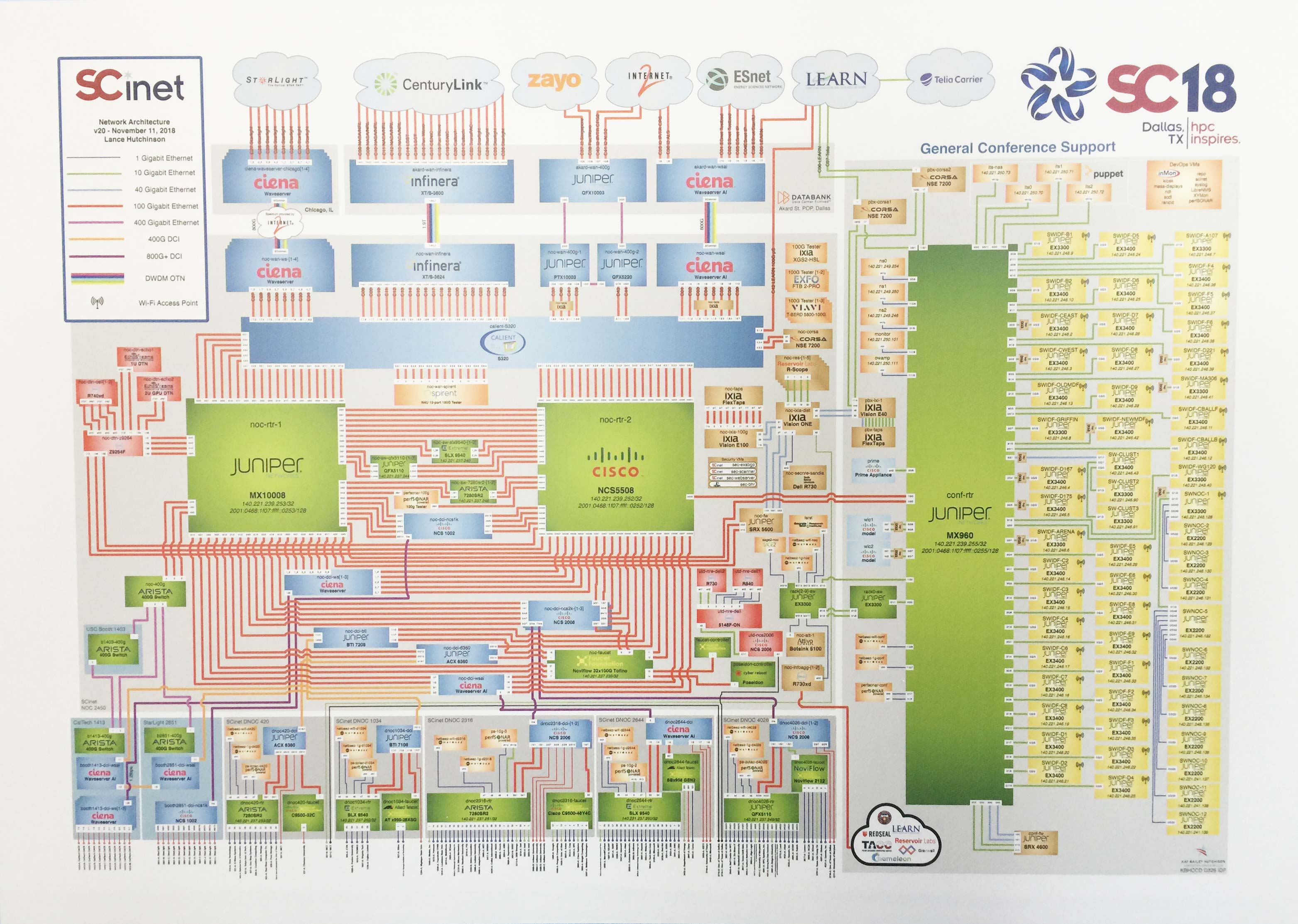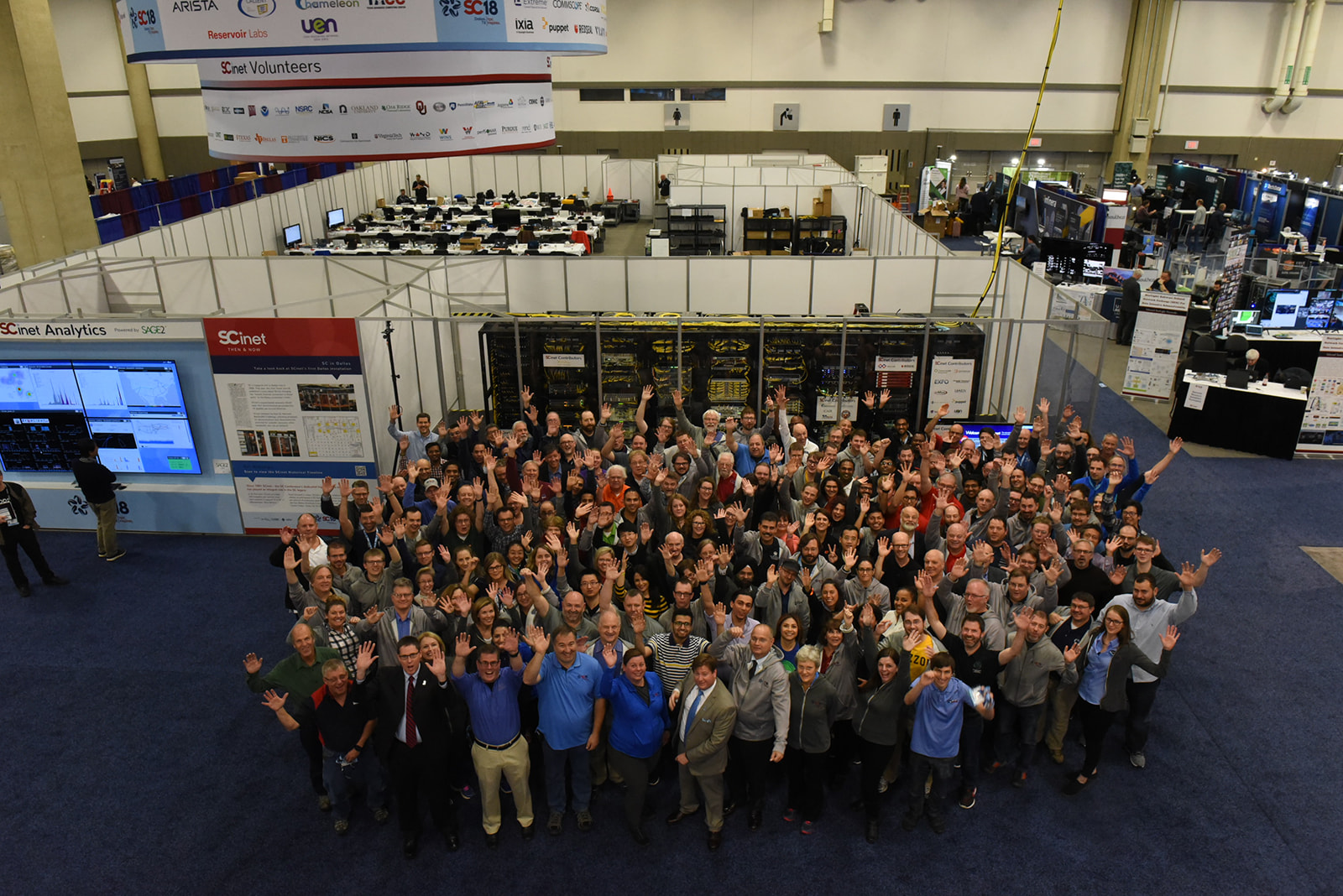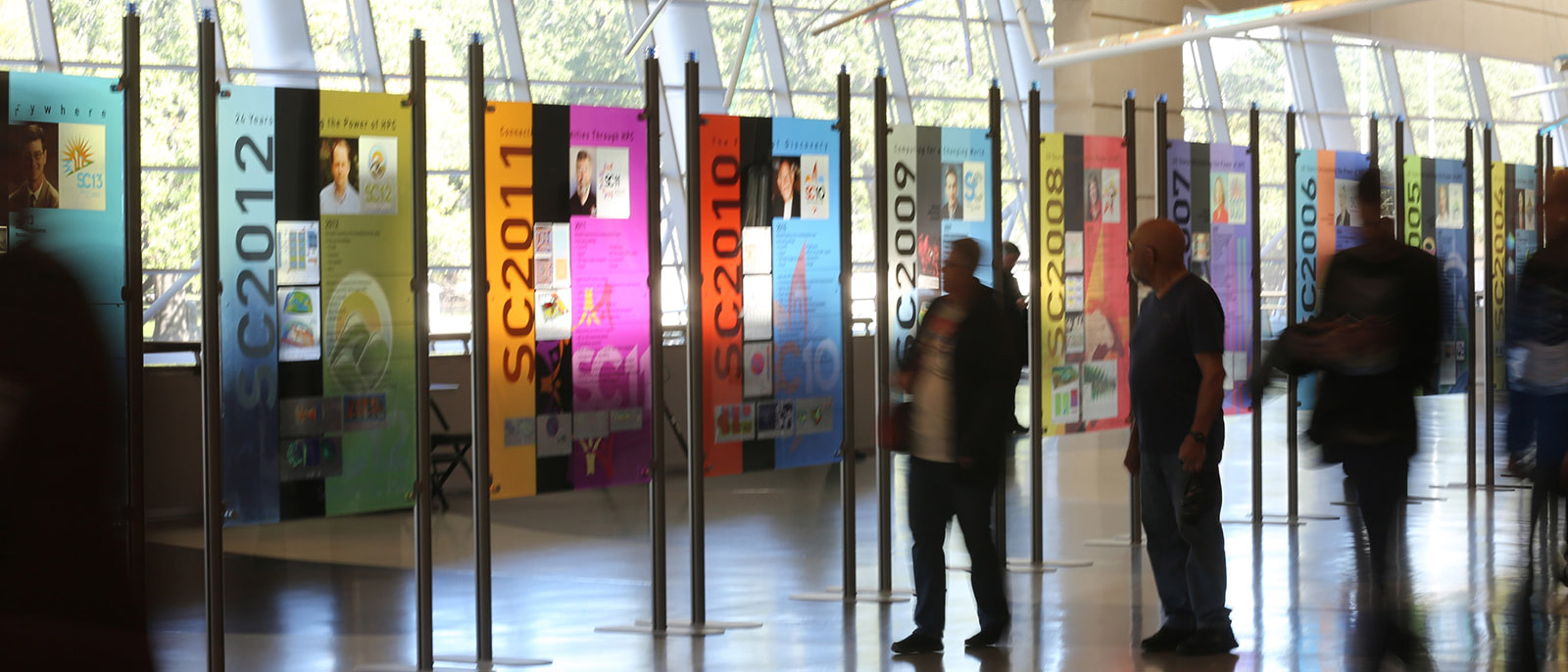By Michael Martinez
Dallas, Texas – For one week in November, the SC18 Supercomputing Conference that’s co-sponsored by the IEEE Computer Society became home to the world’s fastest temporary network.
No complaints about slow WiFi, here.
To become the Earth’s capital of connectivity, conference organizers laid fiber optic cable wherever necessary.
That amounted to 1.3 miles of fiber optic cable under downtown Dallas — including beneath City Hall, the central public library, and other landmarks, ultimately connecting the conference to a big data center. Jackhammers ripped up 25 feet of driveway to make it happen.
Attend an IEEE Computer Society conference
Then, an additional 65 miles – yes, you read that number right — of fiber optic cable was strung through the steel rafters and beneath the carpeting inside the Kay Bailey Hutchinson Convention Center, where the conference was held.
The 66.3 miles of “fiber” was needed because this year’s conference set several new records, including for the number of exhibitors: 364, hailing from 28 countries. They covered nine football fields of space – or 550,000 square feet.
When all was said and done, the network speed hit 4.02 terabits a second — another record apropos of a Supercomputing Conference, the world’s premier gathering for high-performance computing, drawing top professionals from academia, industry, and government.
How fast was it? The 4.02 terabits per second could download Netflix’s entire 4,000 high-definition movie library in 45 seconds flat.
That’s a lot of binge watching.
The hyperspeed was also needed because the conference drew record attendance, at 13,071 participants, surpassing the prior mark of 12,868 in 2015. The gathering’s organizers are the IEEE Computer Society, which took the lead this year in assembling the event, and the Association for Computing Machinery, both nonprofit professional associations
See the IEEE Computer Society conference calendar
“It’s like a homecoming for people in this industry,” SC18 General Chair Ralph McEldowney said in an interview. “It’s the peak of computer pyramid: SC is right at the top of the pyramid, and then there are the sister technologies,” he added.
“SC is an enabler for all of these other things, like AI and machine learning. Not that they need incredible horsepower. But to solve these grand challenges, you need this supercomputing,” he said. “It’s been a great show.”
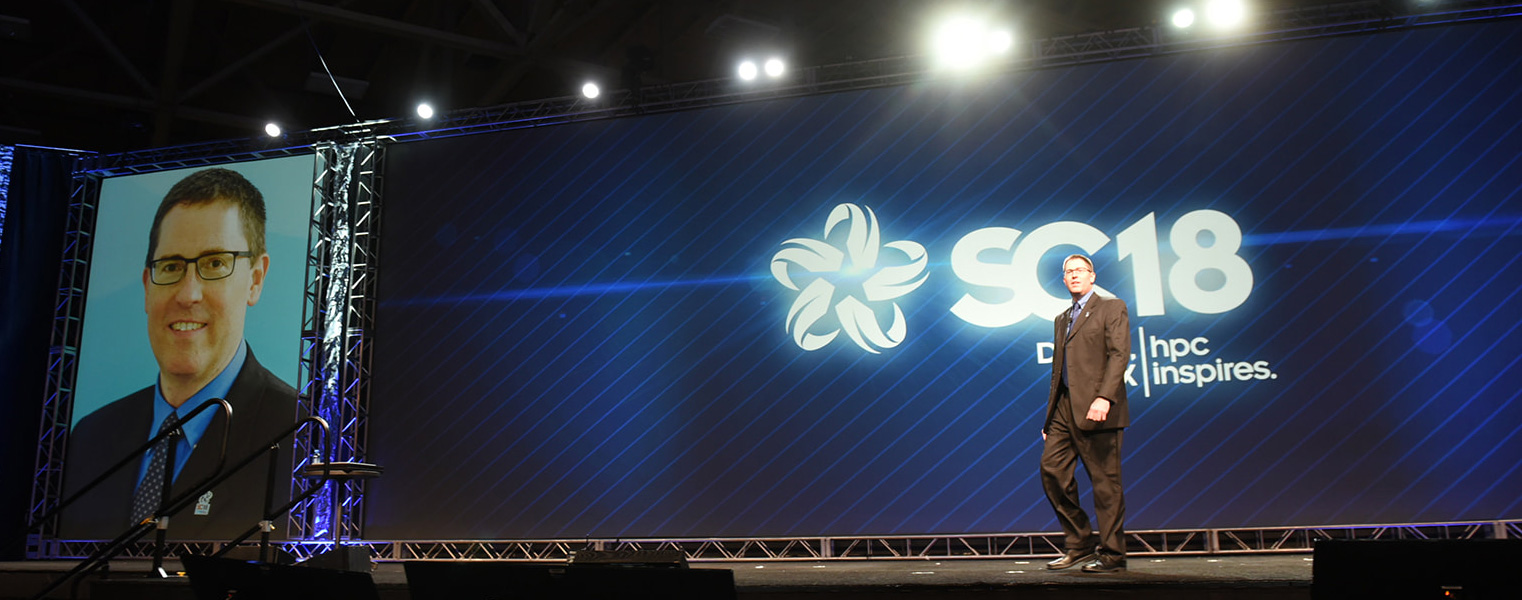
Ralph McEldowney, the general chair of the 2018 Supercomputing Conference, delivers welcoming remarks.
The conference’s growth derives from a sort of arms race between the United States and China, each seeking to dominate the Top500 list of the world’s fastest supercomputers.
“There’s a perception that the U.S. needed to catch up. So there is a probably a little friendly Sputnik competition going on,” said McEldowney, whose full-time job is as the Associate Director for Networking for the U.S. Department of Defense’s High Performance Computing Modernization Program (HPCMP). As a civilian, he is responsible for the Defense Research and Engineering Network (DREN), the premiere high performance wide area network supporting the DoD Research, Development, Test and Evaluation (RDT&E) and Acquisition Engineering communities.
‘A team of rivals’
With NVIDIA, Google, Intel, the U.S. Department of Energy, and Amazon Web Services among those exhibitors with the biggest booths, bandwidth became the coin of the realm, as the industry’s major players demanded fast access to massive data from their far-flung home institutions to cement deals, secure grants, or just make a good impression on clients and competitors alike.
The fiber cable was such an ambitious, expensive project that the 1.3-mile underground portion will remain in place forever, a gift from the conference to the city of Dallas. (The conference generates $40 million in economic impact to the local economy.) The overall network itself cost $52 million in donated equipment and services from exhibitors and participants. Toss in 300 wireless access points at the conference, and the entire operation required some 225 engineers, all volunteers from 85 organizations.
The event also marked an occasion where industry competitors came together and shared: rivals Cisco and Juniper took the center position in the architectural diagram for the planet’s fastest network for a week, a system formally called SCinet, a portmanteau of SC and Internet.
“It’s sort of like a team of rivals,” said SCinet Chair Jason Zurawski, who’s a science engagement engineer at Lawrence Berkeley National Laboratory’s Energy Science Network (ESNet), the high performance networking facility of the U.S. Department of Energy Office of Science. “Everybody here are competitors in the same market.”
So why join forces?
“They want to put their technology in front of the same audience,” he said.
Today’s SC superspeeds are exponentially faster than the conference’s first SCinet in 1991, which offered a mere 245 megabytes a second to attendees, who gathered that year in Albuquerque, New Mexico.
Blow-the-doors off the network
The teamwork was meticulous among the 225 engineers running SCinet: they performed 4,000 fiber patches by hand in order to make the network hum smoothly in the nine racks.
“It’s up to me to motivate them and think big,” said Zurawski, who volunteered to oversee SCinet for the rare experience of managing so many engineers.
The engineers remained especially wary of hackers and how any of the 13,000 attendees could connect an unwittingly infected computer to the network.
“We actually scan and try to find out if something bad is happening out there,” said Zurawski. “There’s always people who are trying to scan or trying to set up botnets.”
To test their mettle, engineers urged all exhibitors and participants to test the network’s integrity and try to overload it between noon and 1 p.m. on a Thursday.
The challenge was appropriately called “Blow-the-doors off the network!”
The system survived – at a conference record 1.25 terabytes per second. The previous record was 1.2 tbps.
“They all came through. This is the biggest and best SCinet ever,” Zurawski said.
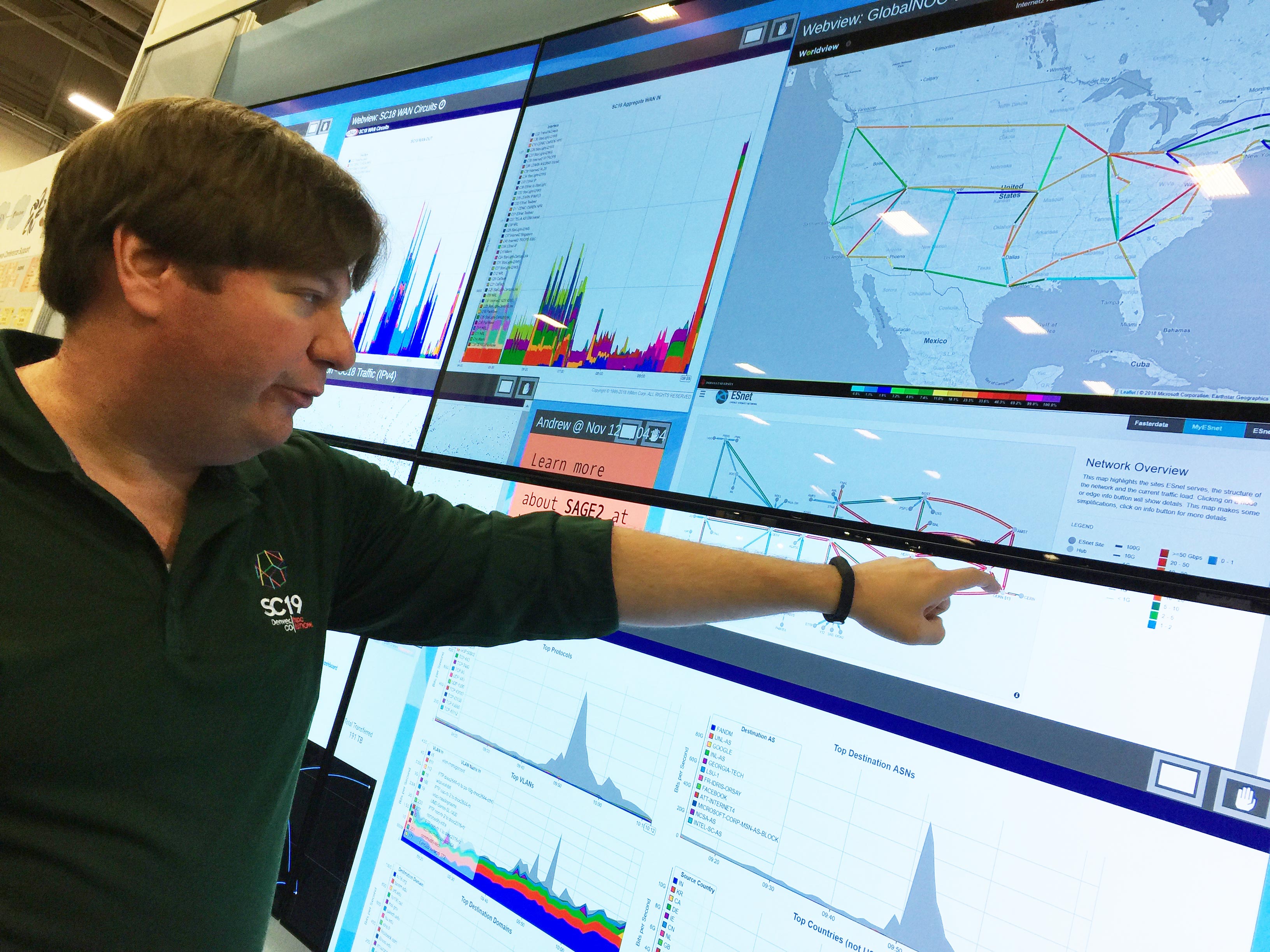
SCinet Chair Jason Zurawski shows the latest analytics on a giant data-visualization monitor for the world’s fastest temporary network.
“Tired feet”
That bandwidth serviced an exhibition space that posted a couple of other conference records: the most exhibitors ever at 364 and the largest footprint of exhibit booths at 150,000 square feet, said SC18 Exhibits Chair Christy Adkinson, who’s also executive projects director for Cray Inc.
SC18 also featured its first-ever “Start-Up” Pavilion in an effort to attract small companies and entrepreneurs to the conference. Each startup was given at a six-foot-long table for their presentations. The pavilion also featured its own barista. The goal of the introductory program is that the startups return in 2019 by renting the minimum 10-foot-by-10-foot booth, which is more expensive than a six-foot table.
“We got 14 startup companies to come. I’m very excited about that,” she said.
Overall, the conference featured its largest number of first-time exhibitors this year, at 60, Adkinson said.
Beside the newcomers were nine long-time exhibitors who were honored with crystal plaques because they attended every SC Conference since 1988.
Visitors spent hours roaming through the industry exhibits within four gargantuan halls. Indeed, Adkinson’s name tag featured a special ribbon: “Tired feet,” it said, a gift from McEldowney, the conference general chair.
“Turning to geeks”
Besides the exhibitions, the conference is also prized for its technical programs and paper presentations by the finest minds in computer engineering and science.
Featured and keynote speakers drew thousands of listeners to a massive meeting hall at the convention center.
The keynote address, by Erik Brynjolfsson of the Massachusetts Institute of Technology, highlighted three major trends in technology: Machines are transforming the role of human decision-making; digital platforms allow products and services of others to be sold and brokered; and ideas generate from the general public rather than experts at the core of the business.
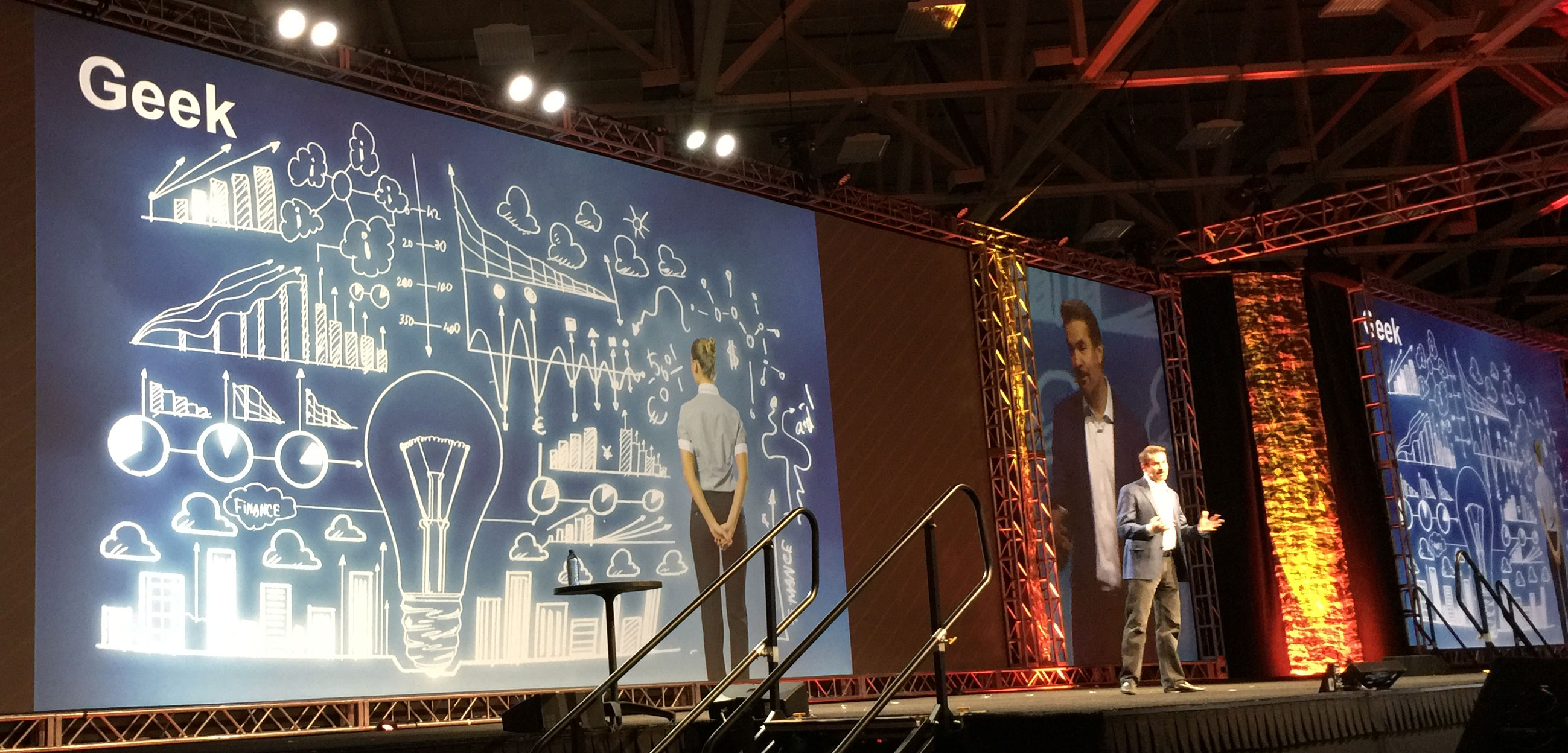
“More and more people are turning to geeks to help them find solutions,” says SC18 Supercomputing Conference keynote speaker Erik Brynjolfsson, who’s director of MIT’s Initiative on the Digital Economy. “Why are geeks more effective?… Geeks have an amazing new ally that they didn’t have before: Digital data.”
“It’s not a revolution. It’s a triple revolution,” Brynjolfsson said. “It’s rethinking of how we do work, from mind to machine, product to platform, core to the crowd.”
Computing professionals stand at the edge of this transformation.
“More and more people are turning to geeks to help them find solutions,” said Brynjolfsson, who holds job titles as the director of MIT’s Initiative on the Digital Economy, the Schussel Family Professor of Management Science at the MIT Sloan School, and a research associate at the National Bureau of Economic Research.
“Why are geeks more effective?… Geeks have an amazing new ally that they didn’t have before: Digital data,” he added.
‘HPC Inspires’
SC18’s slogan was “HPC inspires,” so its opening plenary with a moderated discussion focused on “HPC and Artificial Intelligence – Helping to Solve Humanity’s Grand Challenges.”
Panelists spoke to how high performance computing is revolutionizing how we address and manage global issues from solving global food security challenges to preventing epidemics and understanding the impact of environmental health on urban centers.
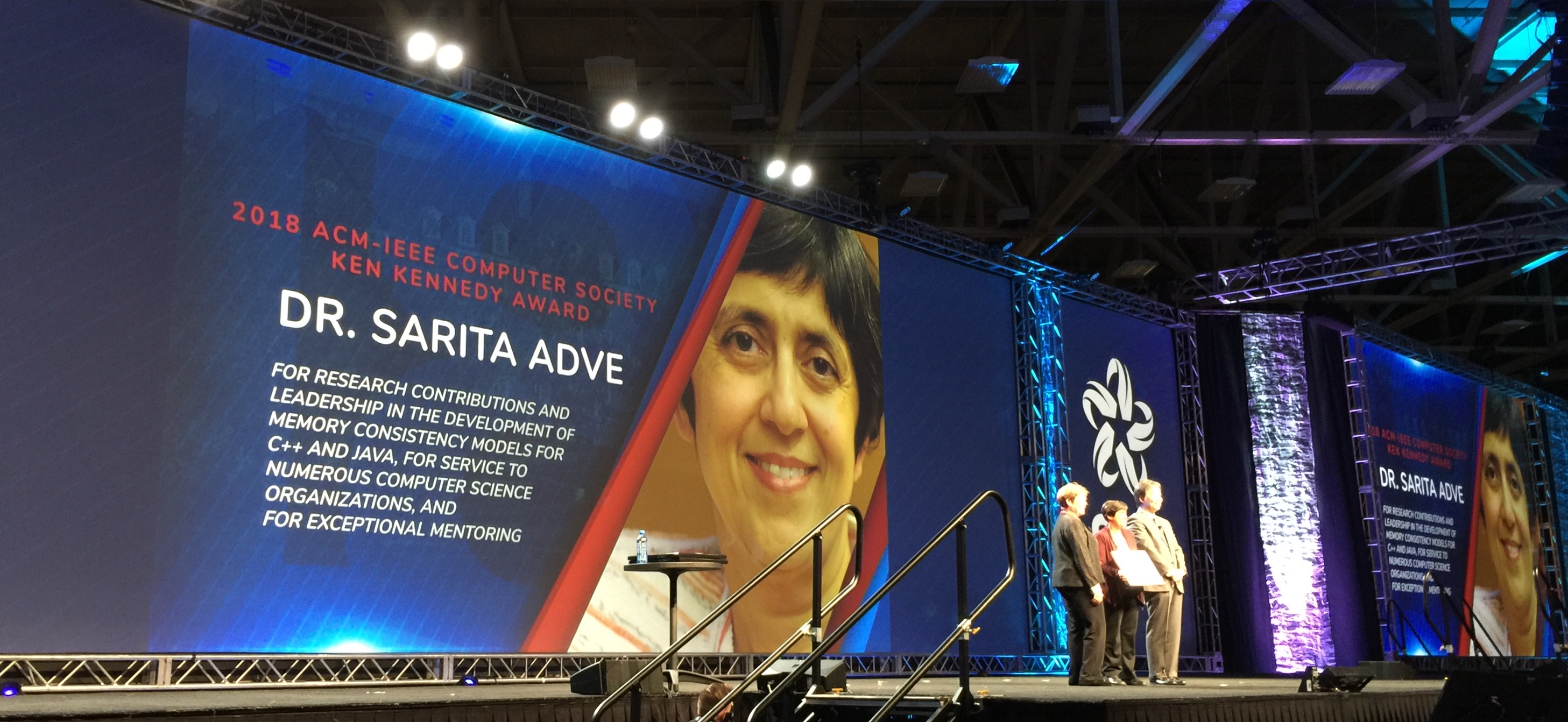
Sarita Adve, the Richard T. Cheng Professor of Computer Science at the University of Illinois, formally receives the 2018 ACM/IEEE Computer Society Ken Kennedy Award.
Several award winners were honored.
Sarita Adve, the Richard T. Cheng Professor of Computer Science at the University of Illinois, formally received the 2018 ACM/IEEE Computer Society Ken Kennedy Award.
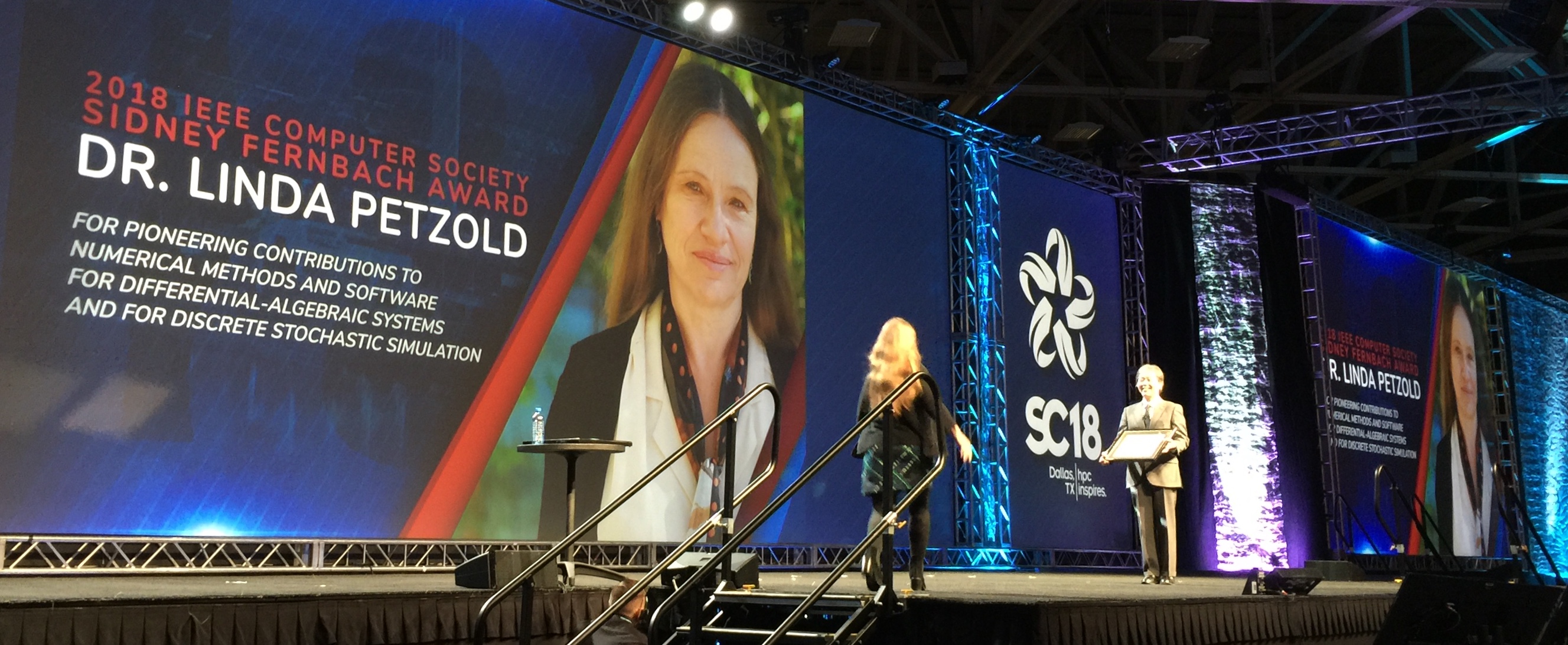
Linda Petzold, the Mehrabian Distinguished Professor in the Department of Computer Science and the Department of Mechanical Engineering and the Director of Computational Science and Engineering Graduate Emphasis at the University of California, Santa Barbara, receives the 2018 IEEE Computer Science Sidney Fernbach Award.
Linda Petzold, the Mehrabian Distinguished Professor in the Department of Computer Science and the Department of Mechanical Engineering and the Director of Computational Science and Engineering Graduate Emphasis at the University of California, Santa Barbara, took the stage to receive formally the 2018 IEEE Computer Science Sidney Fernbach Award.
And David E. Shaw, chief scientist of D.E. Shaw Research and a senior research fellow at the Center for Computational Biology and Bioinformatics at Columbia University, walked across the stage to formally accept the 2018 IEEE Computer Society Seymour Cray Computer Engineering Award.
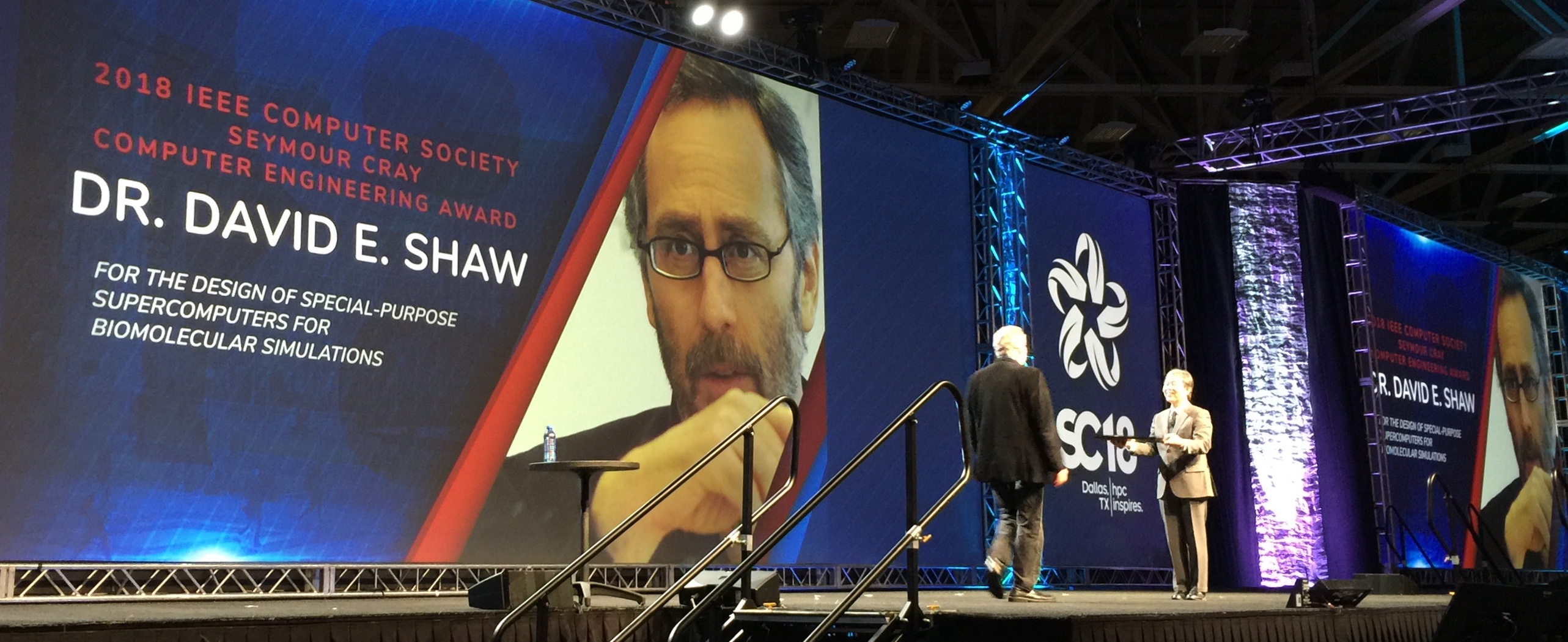
David E. Shaw, chief scientist of D.E. Shaw Research and a senior research fellow at the Center for Computational Biology and Bioinformatics at Columbia University, walks across the stage to formally accept the 2018 IEEE Computer Society Seymour Cray Computer Engineering Award.
The Technical Program also awarded 2 Best Paper Finalists, 5 Best Student Paper Finalists, and 6 Gordon Bell Finalists.
In all, the technical program offered 118 posters, 38 workshops, 35 tutorials, 68 papers (the acceptance rate was 23 percent—“up a little bit over previous years,” McEldowney said), 15 panels, 12 invited speakers, nine HPC Impact Showcase talks, seven emerging tech presentations, and 16 doctoral showcases.
Boosting diversity
The Supercomputing Conference is shorthand for its formal name: the International Conference for High Performance Computing, Networking, Storage, and Analysis.
This year’s 30th anniversary conference featured the most diverse contingent of student volunteers, McEldowney said.
Students came from 27 countries on five continents. Of them, 36 percent were women, 20 percent were Hispanic, and 34 percent were the first in their families to attend college. PhD students accounted for 78 percent of the group.
“We have a robust inclusivity program,” McEldowney said.
Looking ahead: SC19
Next year’s Supercomputing Conference returns to downtown Denver, where the event was held in 2017.
SC19’s tagline will be “HPC is now,” emphasizing how high-performance computing is “now the backbone of our life,” said SC19 General Chair Michela Taufer, the Jack Dongarra Professor in High Performance Computing
at The University of Tennessee.
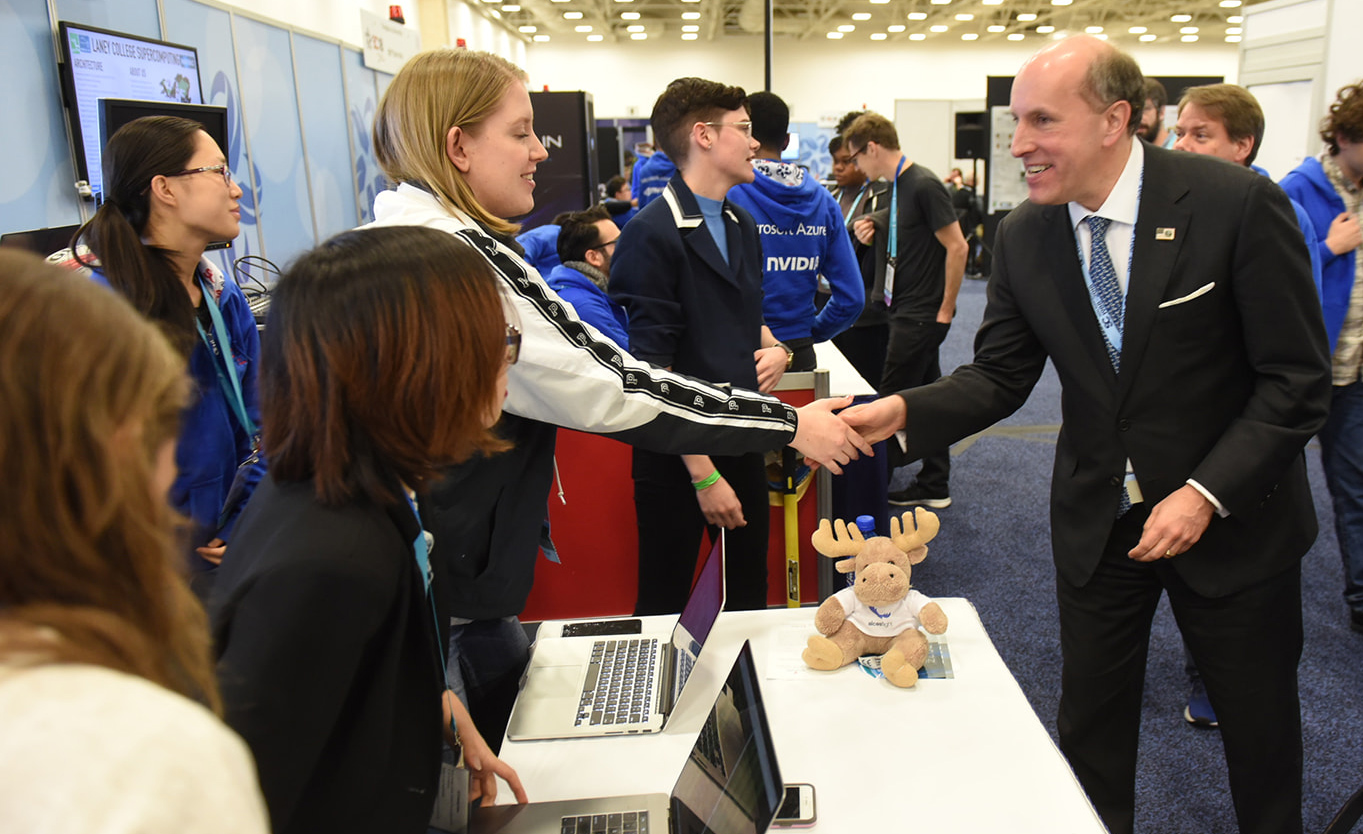
U.S. Department of Energy Under Secretary for Science Paul M. Dabbar greets students on the exhibition floor of SC18.
That is evidenced in smart cities. Self-driving cars. Wind farms.
“We try to raise curiosity and the imagination with attention to the fact the HPC is now. We are inside HPC. We are living it. It’s not tomorrow. It’s not a dream. It is a reality that we are living and that we want to live,” she said. “It’s here and now.”
Crunching the numbers
Fun facts about SCinet (the world’s fastest temporary network whose name derives from SC Conference and Internet):
- 4.02 terabits per second wide area capacity.
- 225 volunteers from 85 organizations.
- $52 million in hardware, software and services provided by 40 SCinet contributors.
- 66.3 miles of fiber (including 1.3 miles to connect Kay Bailey Hutchison Convention Center Dallas to a downtown Dallas datacenter).
- 4,000 fiber patches.
- 300 wireless access points placed throughout 1 million square feet of exhibit space.
Countries represented on the exhibit floor:
Australia (3)
Belgium (1)
Canada (9)
Czech Republic (2)
Finland (1)
France (9)
Germany (11)
Hong Kong (1)
Iceland (1)
Ireland (1)
Italy (2)
Japan (33)
Netherlands (1)
Norway (6)
Peoples Republic of China (14)
Poland (3)
Republic of Korea (5)
Russia (2)
Saudi Arabia (1)
Singapore (1)
Spain (4)
Sweden (1)
Switzerland (1)
Taiwan (7)
United Kingdom (8)
United States (263)

